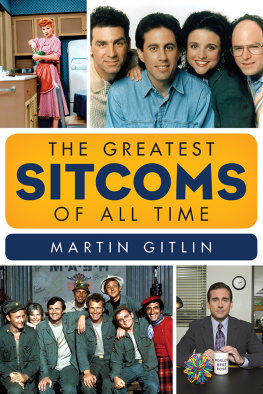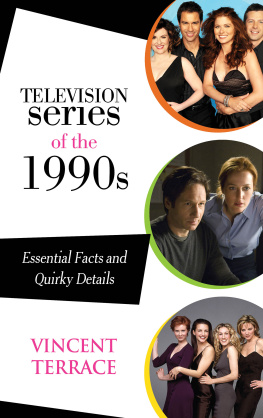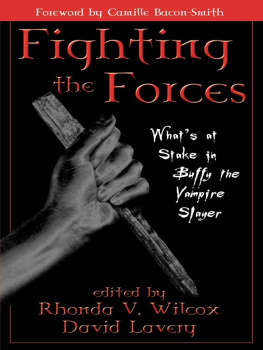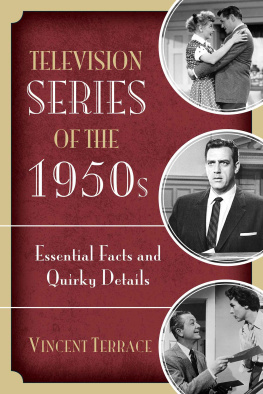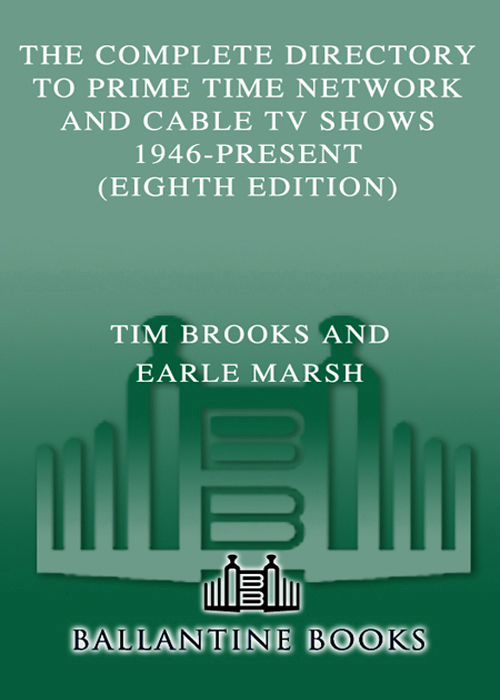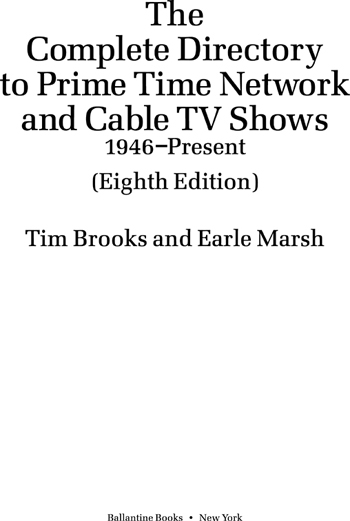What a different world it was 24 years ago, when the first edition of this book was published. Three networks, a nice orderly prime time schedule, and all decisions about what we saw made (as the saying went) by three middle-aged white guys in New York. For most people television was still relatively new, something that had begun during their lifetime, and we were just beginning to see inklings that it had a history. The first major TV retrospectives appeared in the late 1970s, starting with NBCs fiftieth anniversary special in 1976. Not everyone believed there was value in TVs past. Twenty publishers turned this book down, telling us that no one would be interested in a book about old TV shows. What did they know?
Ballantine Books said yes and now, half a million copies later, we bring you the eighth edition of this chronicle of American prime time TV. If we had known back then what TV would look like 24 years latermore than 100 networks (including cable), hundreds of new series every year, Ozzy Osbourne as a sitcom dadwe might never have begun. We are sincerely grateful to our readers for the support that has made it possible to continually update and refine this volume. Popular television may still not get the respect accorded films or the theater you will never see this book reviewed in The New York Timesbut we the viewers dont care, do we?
We are also grateful for your feedback and suggestions. This book is not a factory production but handcrafted, by the two of us, and it is quite a challenge to keep up. As Earle mentioned over lunch the other day, the real miracle is not that the book has grown so much, but that we are still talking to each other, and still friends.
Weve tried to give you the most complete, accurate and interesting book possible on prime time TV. As always, your comments and suggestions are welcome, in care of the publisher.
T.B. and E.M.
ACKNOWLEDGMENTS
Many people both inside and outside of the television industry have helped by providing information used in this edition, and we offer our sincere thanks to them here. We are grateful to our friends at the broadcast and cable networks, many of whom use this book. On the broadcast side they include Brent Petersen at ABC; John Behrens and Nancy Delaney at CBS; Niki Ostin at Fox; Sari DeCesare, Curt King, Claudine Ricanor and Brian Robinette at NBC; and Jay Potashnick and Cathy Schaper at the WB. At the cable networks there were Jennifer Marburg at Animal Planet; Roy Giacopelli at Comedy Central; Matt Katzive at Discovery Channel; Patricia Kollappallil and Gary Morgenstein at Lifetime; Betsy Frank at MTV Networks; Thomas Vitale at the Sci-Fi Channel; and Kat Stein at USA Network.
Others who contributed to the eighth edition included Marc Berman, editor of the industry newsletter The Programming Insider from Mediaweek (), who provided The Ph.D. Trivia Quiz, Ron Simon, curator of The Museum of Television and Radio in New York; and actress Nancy McKeon.
Our readers, who obviously love television as much as we do, continue to write in with (usually) good-natured comments and suggestions. We appreciate your input. All suggestions for additions and corrections are checked and included in future editions if we can confirm them (but note, please be sure of your facts, providing sources if possible; memories, no matter how certain, can be mistaken!). We regret that we cannot personally answer every letter, but we do read them and want to thank the following whose contributions will be found in this edition: Barbara Arnstein, Aaron Barnhart, Robert E. Blank, James Clink, Phyllis Cohen, Emily V. Dais, Charleen Dale, Brandon Haleamau, Nelson T. Hall, David P. Jackino, Jeff Jourdan, Katalin Korossy, Joy Lewis, Barrie Pick, Edward J. Powers, Rick Rofman and Stephen Tuttle.
Finally, our thanks to our understanding and helpful editors at Ballantine Books for this edition, Patricia Peters and Mark Tavani.
Comments are welcome c/o Ballantine Books, 1745 Broadway, New York, NY 10019.
INTRODUCTION
Wait no more, here it isnearly 60 years of television at your fingertips. From I Love Lucy to Everybody Loves Raymond, Milton Berle to Malcolm in the Middle, Toast of the Town to Touched by an Angeldetailed information on all the shows you loved, whatever their era. Television shows never really die, you know, they just keep being rerun, on and on. So if you stumble into the middle of The X-Files or Buffy the Vampire Slayer, well help you untangle the plot. If youre a romantic, you can relive the love affairs on Moonlighting and Mad about You. For the historians weve exhumed information on the first network news programs, on Amos n Andy, and on the first major TV production, the now-forgotten Hour Glass (1946). And there are thousands of others, flickering through the yearsThe Lone Ranger, Arthur Godfreys Talent Scouts (who says American Idol is a new idea?), Gunsmoke, The Beverly Hillbillies, Gomer Pyle, Rowan & Martins Laugh-In, All in the Family, Happy Days, Hill Street Blues, Dallas (about which we get lots of letters), Dynasty (not so many), The Cosby Show, ER, South Park, The Real World, The West Wing, Rugrats, Lizzie McGuire, Survivor, The Bachelor, and many more.
We both work, or have worked, in the TV industry, care about its history, and have done everything possible to get the facts correct. That doesnt mean there are no mistakes we will surely hear about them!but we hope not many. If you have an earlier edition of this book, there are thousands of additions and improvements, appearing on almost every page. The book has been carefully researched for the scholar, but it is also, like television itself, for your enjoyment (as well as for trivia quizzes, bet settling, and spouse pacifying on a birthday or holiday). Guard your copy, though. People get so interested in whats in here that the book might walk away. You can still watch many of these shows, on broadcast stations, cable networks, tape or DVD. We hope this book will help you enjoy them even more.
What Is in This Book
This encyclopedia lists regular series carried on the commercial broadcast and cable networks between 6:00 P.M. and roughly 3:00 A.M. eastern timein other words, prime time plus early evening and late-night programs. In addition, we have included all the top syndicated programs that have aired primarily in the evening hours. We cover the entire history of TV networking in the United States, from its inception on a regular basis in 1944 through April 15, 2003. Our definition of a series is a program that ran for at least four consecutive weeks in the same time slotor was intended to!
A few generic program types are found under general headings. Newscasts are summarized under News; sports events such as football, boxing, wrestling, etc., under the name of the sport; and feature film series under Movies. All other series are arranged by title in alphabetical order. There is a full index in the back to every cast member, plus appendixes listing the highest rated programs each season, network schedules for each season at a glance, major TV awards, and other information.
Network series are those that are fed out by broadcast or cable networks and seen simultaneously across most of the country. The following broadcast networks are covered, beginning with the year shown. Although individual program clearance information for the earliest years is anything but clear, well also indicate our best guess as to each networks first regular prime-time series.


